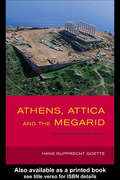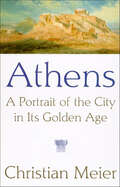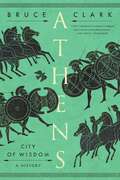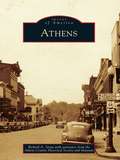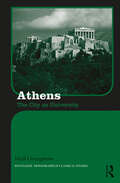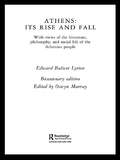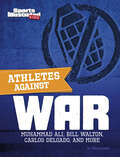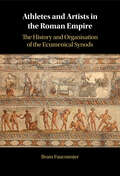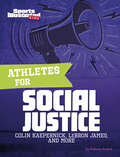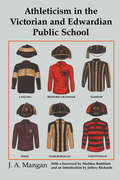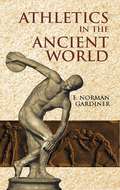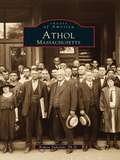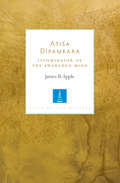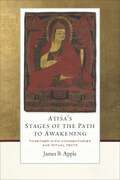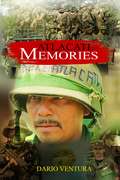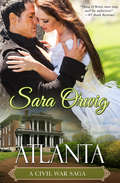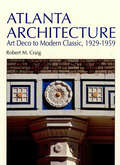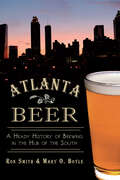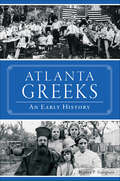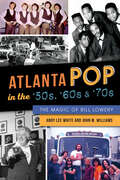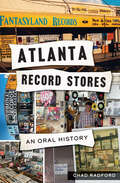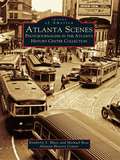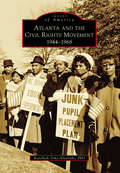- Table View
- List View
Athens, Attica and the Megarid: An Archaeological Guide
by Hans Rupprecht GoetteThis exciting new guide is the ideal companion to Greece if you are a traveller with historical and archaeological interests, as it combines practical information with impeccable scholarly research.Written by an expert on Greece's landscape and archaeology, the guide is unique in exploring a wide range of sites off the beaten track. It also tours all the best-known monuments and regions, from the Acropolis to Aegina, from Megara to Marathon and from Sounion to Salamis.Beautifully illustrated with over 200 plates, maps, plans and drawings, it includes:* precise descriptions of routes and individual sites* artistic, historical, social and political background* unprecedented coverage outside Athens* detailed exploration of the post-classical, Byzantine and post-Byzantine periods.Take it with you on your travels or read it at home; either way, you will gain a deeper appreciation and enjoyment of Greece's history and archaeology.
Athens, Thrace, and the Shaping of Athenian Leadership
by Matthew A. SearsFrom the mid-sixth to the mid-fourth century BCE a nexus of connections to Thrace defined the careers of several of Athens' most prominent figures, including Pisistratus, Miltiades, Alcibiades, and Iphicrates. This book explores the importance of Thrace to these individuals and its resulting significance in the political, cultural, and social history of Athens. Thrace was vitally important for Athens thanks to its natural resources and access to strategic waterways, which were essential to a maritime empire, and connections to the area conferred wealth and military influence on certain Athenians and offered them a refuge if they faced political persecution at home. However, Thrace's importance to prominent individuals transcended politics: its culture was also an important draw. Thrace was a world free of Athenian political, social, and cultural constraints - one that bore a striking resemblance to the world of Homeric epic.
Athens: A Portrait of the City in Its Golden Age
by Christian MeierA lively and accessible history of Athens's rise to greatness, from one of the foremost classical historians.The definitive account of Athens in the age of Pericles, Christian Meier's gripping study begins with the Greek triumph over Persia at the Battle of Salamis, one of the most significant military victories in history. Meier shows how that victory decisively established Athens's military dominance in the Mediterranean and made possible its rise to preeminence in almost every field of human eavor--commerce, science, philosophy, art, architecture, and literature. Within seventy-five years, Athens had become the most original and innovative civilization the ancient world ever produced.With elegant narrative style, Meier traces the birth of democracy and the flourishing of Greek culture in the fifth century B.C., as well as Athens' slow decline and defeat in the Peloponnesian War. The great figures--from politicians and generals like Themistocles and Alcibiades to the philosophers Socrates and Plato--emerge as flesh-and-blood human beings, firmly rooted in their times and places. This is history in the tradition of Simon Schama and Barbara Tuchman--learned, accessible, and beautifully written.
Athens: City of Wisdom
by Bruce ClarkA sweeping narrative history of Athens, telling the three-thousand-year story of the birthplace of Western civilization.Even on the most smog-bound of days, the rocky outcrop on which the Acropolis stands is visible above the sprawling roof-scape of the Greek capital. Athens presents one of the most recognizable and symbolically potent panoramas of any of the world's cities: the pillars and pediments of the Parthenon – the temple dedicated to Athena, goddess of wisdom, that crowns the Acropolis – dominate a city whose name is synonymous for many with civilization itself. It is hard not to feel the hand of history in such a place. The birthplace of democracy, Western philosophy and theatre, Athens' importance cannot be understated. Few cities have enjoyed a history so rich in artistic creativity and the making of ideas; or one so curiously patterned by alternating cycles of turbulence and quietness. From the legal reforms of the lawmaker Solon in the sixth century BCE to the travails of early twenty-first century Athens, as it struggles with the legacy of the economic crises of the 2000s, Clark brings the city's history to life, evoking its cultural richness and political resonance in this epic, kaleidoscopic history.
Athens: Excavations And Studies Conducted By The University Of Pennsylvania Museum And The British School At Athens (Images of America)
by Richard A. Straw Athens County Historical Society and MuseumIn the late 1700s, a group of men, largely from Massachusetts, came into the foothills of the Appalachian Mountains and settled a village in southeastern Ohio alongside the Hocking River. Calling it Athens to honor their belief in the primacy of education and culture in one's life, they set in motion a history that continues to inform and enliven life within this community today. Ohio University, the first public institution of higher learning in the Northwest Territory, was founded here in 1804. Athens has served as a business, service, cultural, and educational meeting place for over 200 years. As a result, Athens is a culturally diverse community of professors, plumbers, lawyers, craftsmen, restaurateurs, students, musicians, artists, and business owners, and it is heir to a historic past. This collection of fascinating photographs of people, places, homes, businesses, churches, and important events comes from the vast archives of the Athens County Historical Society and Museum. The images open the past and provide an informative glimpse into an earlier period of life in this unique community.
Athens: The City as University (Routledge Monographs in Classical Studies)
by Niall LivingstoneThe citizens of ancient Athens were directly responsible for the development and power of its democracy; but how did they learn about politics and what their roles were within it? In this volume Livingstone argues that learning about political praxis (how to be a citizen) was an integral part of the everyday life of ancient Athenians. In the streets, shops and other meeting-places of the city people from all levels of society, from slaves to the very wealthy, exchanged knowledge and competed for power and status. The City as University explores the spaces and occasions where Athenians practised the arts of citizenship for which they and their city became famous. In the agora and on the pnyx, Athenian democracy was about performance and oratory; but the written word opened the way to ever-increasing sophistication in both the practice and theory of politics. As the arts of spin proliferated, spontaneous live debate in which the speaker’s authority came from being one of the many remained a core democratic value. Livingstone explores how ideas of democratic leadership evolved from the poetry of the legendary law-giver Solon to the writings of the sophist Alcidamas of Elaia. The volume offers a new approach to the study of ancient education and will be an invaluable tool to students of ancient politics and culture, and to all those studying the history of democracy.
Athens: With Views of the Literature, Philosophy, and Social Life of the Athenian People
by Edward Bulwer LyttonAthens: Its Rise and Fall, originally published in 1837, is the most important and readable of the Victorian histories of ancient Greece. It stands alongside Macauley and Carlyle as a great historical work of British Romanticism, and anticipates the thinking of George Grote and John Stuart Mill on Greek history by over a decade. Originally published in two volumes, this new one-volume edition includes the text of the never-before published 'third volume' on which he was working at the time of his death, recently rediscovered by Oxford academic Oswyn Murray. An absolute must for any scholar of ancient Greece.
Athletes Against War: Muhammad Ali, Bill Walton, Carlos Delgado, and More (Sports Illustrated Kids: Activist Athletes)
by Elliott SmithActivists take a stand. They speak out and demand change. From legendary boxer Muhammad Ali to baseball star Carlos Delgado, readers discover the pro athletes who have affected change by speaking out against war and its impact on society.
Athletes and Artists in the Roman Empire: The History and Organisation of the Ecumenical Synods
by Bram FauconnierThis is the first comprehensive study of the associations of athletes and artists in the Roman empire. The xystic synod of athletes and the thymelic synod of artists were the only ancient associations that operated on a pan-Mediterranean scale. They were active from southern Gaul to Syria and Egypt and were therefore styled 'ecumenical synods'. They played a key role in Greek festival culture during the imperial period: not only did they defend the professional interests of their members, they also contributed to the organisation of competitions and the maintenance of the festival network. Due to their cultural activities, their connections with the imperial court and their ramified social networks, they left a distinctive stamp on Greco-Roman elite culture during the Principate. Drawing on all available documentation, this book offers new insights into the history and workings of these remarkable associations.
Athletes for Social Justice: Colin Kaepernick, LeBron James, and More (Sports Illustrated Kids: Activist Athletes)
by Dolores AndralTaking a stand and being an activist means having the courage to speak up for an important cause. For football player Colin Kaepernick and basketball great LeBron James, fighting for social justice is their top priority. Learn how they and other players use their platform as celebrity athletes to bring attention and change to the cause of social justice.
Athleticism in the Victorian and Edwardian Public School: The Emergence and Consolidation of an Educational Ideology (Sport in the Global Society)
by J. A. ManganGames obsessed the Victorian and Edwardian public schools. The obsession has become widely known as athleticism. When it appeared in 1981, this book was the first major study of the games ethos which dominated the lives of many Victorian and Edwardian public schoolboys. Written with Professor Mangan's customary panache, it has become a classic, the seminal work on the social and cultural history of modern sport.
Athletics in the Ancient World
by E. Norman GardinerThis comprehensive text focuses mostly on athletics in classical Greece and Rome, emphasizing the relationship between athletics and religion, art, and education. Also discussed are such events as throwing the discus and javelin, the pentathlon, the stadium and the foot-race, jumping, wrestling, boxing, ball play, and a Greek athletic festival. 137 black-and-white illustrations.
Athol, Massachusettes
by Robert TuholskiNestled among the hills of Massachusetts, 70 mileswest of Boston, Athol lies on the banks of the Millers River. First settled as "Pequoiag" in 1735 and incorporated as Athol in 1762, the evolution of Athol from a sparse, agrarian settlement to a bustling industrial community is a blueprint for the transformation of small-town America. This exciting collection presents a visual history of Athol at the dawn of the twentieth century. Athol, Massachusettsdocuments the changes as the town developed from an agrarian community into a thriving manufacturing center that harnessed Mill Brook and the Millers River to power the early mills. Through photographs, stereo cards, and postcards from a bygone era, this book provides a glimpse of what it was like to live and work in the Athol of long ago. The photographs from years gone by allow both young and old to meander down dirt roads along the stream, and become witness to their celebrations and their recreational retreats at the fairgrounds, Silver Lake, and Brookside Park.
Atisa Dipamkara: Illuminator of the Awakened Mind (Lives of the Masters)
by James B. AppleThe first-ever biography with selected writings of one of the greatest Indian Buddhist masters in history.Few figures in the history of Buddhism in Tibet have had as far-reaching and profound an influence as the Indian scholar and adept Atiśa Dīpaṃkara (982–1054). Originally from Bengal, Atiśa was a tantric Buddhist master during Vajrayana Buddhism’s flowering in India and traveled extensively, eventually spending the remaining twelve years of his life revitalizing Buddhism in Tibet. Revered by all the schools of Tibetan Buddhism, Atiśa and his students founded what came to be known as the Kadam school, whose teachings have influenced countless Buddhist masters. These teachings, cherished by all major traditions, are preserved by the Geluk in particular, the school of the Dalai Lamas. Although Atiśa was an influential practitioner and scholar of Tantra, he is best known for introducing many of the core Mahayana teachings that are widely practiced throughout the Tibetan Buddhist world, including the Stages of the Path to Awakening and Mind Training (lojong), as well as having contributed to highly influential commentaries on Madhyamaka that synthesize various schools of thought. This succinct biography of Atiśa’s life, together with a collection of translations, represents for the first time the full range of Atiśa’s contribution to Buddhism. As the most comprehensive work available on this essential Buddhist figure, this book is an indispensable resource for scholars and Buddhist practitioners alike.
Atisa's Stages of the Path to Awakening: Together with Commentaries and Ritual Texts
by James B. AppleThis book contains a lost Stages of the Path (Lamrim) work composed by the originator of the genre, Atisa, one of the greatest Indian Buddhist masters to ever set foot in Tibet.Nearly a millennium ago, the great Indian Buddhist master Atisa Dipamkarasrijñana (ca. 982–1054) wrote a guidebook for realizing all the stages to awakening at the repeated request of his closest Tibetan disciple. Atisa is famously the author of the Lamp for the Path to Awakening (Bodhipathapradipa), a short work in verse, but this longer prose work has been virtually unknown, even in Tibet—until now. Atisa&’s Stages of the Path Awakening (Bodhipathakrama), translated here, synthesizes all aspects of Buddhist practice, from the very beginning of the path—reflecting on the fortunate opportunity of human rebirth—up through to attaining omniscient buddhahood by nondual meditation. The Indian master&’s faithful disciple Dromtönpa kept these teachings secret, and they were only transmitted to select disciples in a closely guarded transmission, but the lineage died out centuries ago, after Dromtönpa&’s Kadam school was eclipsed by history. Now this significant work of Buddhist path literature has become available owing to recently recovered manuscripts of the Kadampas. This book offers a study and complete translation from the Tibetan of this monument of guidance on the Buddhist path accompanied by the commentaries and ritual texts that were transmitted alongside Atisa&’s text. Apple&’s substantial introduction includes a structural comparison with Atisa&’s famous work, charts the transmission lineage for the present work before it died out, and explores various hypotheses for why their fates diverged. Recovered from the contingencies of history, this book brings to life one of the most holistic and integrated approaches to the highest realizations of the Indian Buddhist path ever transmitted in Tibet.
Atit O Oitijhya (Past and Heritage) class 6 - West Bengal Board: অতীত ও ঐতিহ্য ষষ্ঠ শ্রেণি
by West Bengal Board of Secondary Educationঅতীত ও ঐতিহ্য ষষ্ঠ শ্রেণির ইতিহাসের পাঠ্যপুস্তক, যা পশ্চিমবঙ্গ মধ্যশিক্ষা পর্ষদের অধীনে প্রকাশিত। এটি জাতীয় পাঠক্রমের রূপরেখা ২০০৫ এবং শিক্ষার অধিকার আইন ২০০৯-এর ভিত্তিতে তৈরি করা হয়েছে, যাতে শিক্ষার্থীরা ইতিহাসকে সহজ ও আকর্ষণীয়ভাবে শিখতে পারে। বইটি গল্পের আকারে রচিত, যেখানে চিত্র, মানচিত্র এবং কৌতূহলোদ্দীপক অনুশীলন সংযোজিত হয়েছে। এটি ভারতের প্রাচীন সভ্যতা, মানবসমাজের বিকাশ ও সাংস্কৃতিক বিবর্তনকে তুলে ধরে। পাঠ্যক্রমটি শিক্ষার্থীদের অনুসন্ধানমূলক শিক্ষা পদ্ধতিতে উৎসাহিত করে এবং কবে, কেন, কীভাবে, কোথায় এই প্রশ্নগুলোর মাধ্যমে ইতিহাসের ঘটনা বিশ্লেষণ করতে শেখায়। বইটিতে প্রত্নতাত্ত্বিক নিদর্শন ও সাহিত্যিক উৎসের মাধ্যমে ভারতের অতীতের পুনর্গঠন করা হয়েছে।
Atlacatl Memories: There is not anything to translate. (There is not anything to translate. #1)
by Jeffrey Stuart IsfeldMEMORIES FROM ATLACATL by Dario Ventura FROM WAR TO PEACE A story told by ex-Salvadoran military personnel of their life and experiences during the Salvadoran civil war Memories of Atlacatl Testimonial book on one of the battalions of the Salvadoran civil war: BIRl Atlacatl, testimonial narratives of its former members Today I got up with the invitation to continue as a mute observer of today's veterans of the civil war, in silence so as not to cloud The story that they are determined to tell without being observed, the change of opinion of the military has surprised me; After more than 30 years of the civil war, everyone has made a decision not to tell their stories, but in an act of no less heroism than during the war they have decided to expose part of their experiences during the war. I have put myself behind the monitor to watch and listen to the film of their own lives, the countless hours remembering what was never contacted before by their own authors, their memories, the memories of Atlacatl.
Atlanta (The Civil War Saga #3)
by Sara OrwigThe conclusion to the USA Today–bestselling author&’s sweeping historical romance trilogy is &“a page-turner&” (Romantic Times). The Northern soldiers ravaged Atlanta during the Civil War. Now as the city attempts to recover, all Claire Dryden has left is the little boy she has adopted and sworn to protect with her life. When the handsome Yankee colonel Fortune O&’Brien storms into town demanding to reclaim the boy he claims is his stolen son, Claire&’s vow is put to the test. For she loves the boy more than life itself, but the passion O&’Brien ignites in her threatens to weaken her resolve . . . With Atlanta, the author of New Orleans and Memphis completes this trilogy of passionate love stories set against the dramatic backdrop of the Civil War. &“Fast-paced action and escalating romantic tension . . . These O&’Brien men may well be addictive!&” —Romantic Times &“A wonderful romance told with passion and style . . . Well-developed characters . . . This book is HOT.&” —Affaire de Coeur
Atlanta Architecture: Art Deco to Modern Classic, 1929-1959 (Atlanta Architecture)
by Robert M. CraigHaving been one the most successful boomtowns of the early twentieth century, Atlanta saw a transition from a town known for its Southern charm and history to a business hub. The result is a colorful mix of antebellum restorations and modern styles. Art Deco brought in cosmetic and theatrical elements to facades and interiors with examples like the Southern Bell Telephone Company Building, the Atlanta City Hall, and the W. W. Orr Doctors Building. Meanwhile, the Modern Classic was born out of the Public Works Administration projects of the Great Depression. Emphasizing a minimized classicism and trading artistic ornamentals for a more bureaucratic look, these buildings exemplify the style of the New Deal era as seen in the Federal Post Office, the Masonic Temple, and the public housing project of Techwood Homes. Craig also gives past-due credit to the designers themselves like Pringle & Smith, G. Lloyd Preacher, and A. Ten Eyck Brown, who deserve to be remembered among the century&’s noteworthy architects. From government offices to houses to movie theatres to retail stores, their history and features are covered in detail in this work, which adds to the resources available for historians, architects, and architectural aficionados.
Atlanta Beer: A Heady History of Brewing in the Hub of the South (American Palate Ser.)
by Ron Smith Mary O. Boyle&“Delve[s] into a colorful past . . . Stories of early taverns and saloons, religious zeal, prohibition and the roots of the current craft beer boom.&” —Atlanta Journal Constitution Atlanta is a unique southern city known for its vast diversity and fast-paced lifestyle. Rarely is it associated with a rich beer and brewing culture, but not for a lack of one. From Atlanta&’s first brewery in the 1850s to the city&’s Saloon Row and the parched days of local and national Prohibition, the earliest days of Atlanta&’s beer history are laced with scandal and excitement. Follow the journey of beer through Atlanta&’s development, starting with colonial Georgia and the budding wilderness settlement of Terminus and eventually evolving into the ever-growing metropolis known as Atlanta. Authors Ron Smith and Mary Boyle celebrate the resurgence of craft beer in a town that once burned to the ground. As Atlanta rose from the ashes of the Civil War, so also has artisanal beer made a comeback in this enigmatic but resilient city. &“The brewery sections draw attention to some long-neglected businesses . . . But the chapter on Prohibition may be the most fascinating part of the book.&” —American Breweriana Journal &“A fascinating read for any craft beer lover in the Southeast. The book features chapters on frontier taverns of the area, Atlanta&’s first beer boom, stories of early breweries of the city, the brewpub trend and the rise of current breweries located in Georgia&’s capital.&” —Owen Ogletree&’s Brewtopia Brewsletter
Atlanta Greeks: An Early History (American Heritage Ser.)
by Stephen P. GeorgesonBy 1890, the first Greek immigrants to Atlanta had settled into an area still widely populated by Confederate veterans. In a city without the large immigrant presence common in the nation's major urban areas, the Greeks were initially received as undesirable visitors by the state's and city's leaders. While the Greek Orthodox Church of Atlanta endured financial hardship, it continued to aid funerals, hospitals and orphanages. These Greeks moved from the city's streets as fruit vendors into more established businesses. Christ Gyfteas's fruit stand at the corner of Broad and Marietta became the California Fruit Company. By 1911, 40 percent of Greeks were proprietors or partners in a variety of businesses like cafés, restaurants, soda fountains and groceries. Author Stephen Georgeson explores the Greek immigrants' experiences in their first three decades in Atlanta.
Atlanta Pop in the '50s, '60s & '70s: The Magic of Bill Lowery
by Andy Lee White Williams M JohnDiscover the people and places that made Atlanta the pop music capital of the United States in the second half of the twentieth century.Former DJ Bill Lowery attracted a galaxy of talent and created an empire of music publishing, production and promotion. In 1956, the Lowery Music Company had its first million copy-selling hit single with &“Be-Bop-a-Lula,&” by Gene Vincent. Under Lowery&’s direction, popular artists like Tommy Roe and Billy Joe Royal flourished. Audio engineer Rodney Mills teamed up with Lowery and future Atlanta Rhythm Section manager Buddy Buie to build Studio One, a recording studio that produced albums from legendary acts such as Joe South, Lynyrd Skynyrd, 38 Special and others. Andy Lee White and John M. Williams offer a comprehensive portrait of the vibrant postwar Atlanta music scene.&“Insight and memories from major behind the scenes figures like engineer, producer and Georgia Music Hall of Fame member, Rodney Mills (Lynyrd Skynyrd, Atlanta Rhythm Section, Gregg Almond, Joe South) along with Bob &“Tub&” Langford (engineer for Joe South&’s biggest hits and Lynyrd Skynyrd&’s &“Freebird&”) help tell previously untold memories from a special time for Atlanta music like none before or since.&” —East Cobber
Atlanta Record Stores: An Oral History
by Chad RadfordAtlanta Record Stores is an oral history of the city's rock music scene, as witnessed through the lens of Criminal Records, Fantasyland, Wax 'N' Facts, and many more. This is a rock-centric take on a town that's so often praised and admired around the world as a hip-hop mecca. Here, the secret history of the underdogs--outsiders living among outsiders--are told. From Jarboe of SWANS to William DuVall of Alice In Chains and Neon Christ, to Kelly Hogan, and those surly guys behind the counter at Wuxtry, all were drawn by the irresistible lure of vinyl records, all found their communities and their own identities, leaving an indelible mark on the culture of Atlanta. Now, in their own voices, their stories are told.
Atlanta Scenes: Photojournalism in the Atlanta History Center Collection
by Michael Rose Atlanta History Center Kimberly S. BlassAtlanta, the thriving capital of the New South, has a rich and fascinating history. In Atlanta Scenes, authors Kimberly S. Blass and Michael Rose draw from the works of some of the city's earliest and finest photojournalists--Francis Price, Marion Johnson, Bill Wilson, and Kenneth Rogers--to bring that history to life. Atlanta Scenes documents some of the city's noteworthy events, personalities, and landmarks, many of which will be readily identifiable. The images range from the everyday (baseball games at Ponce de Leon Ballpark, boys on bicycles, and Humane Society dog rescues) to the eventful (the Gone with the Wind premiere, the deadly Winecoff Hotel fire, and the infamous Leo Frank trial). Many scenes reflect the iconography of the Old South, while others provide insight into the harsh realities of twentieth-century life. In this volume, well-crafted, artistic images blend with on-the-spot action shots.
Atlanta and the Civil Rights Movement: 1944-1968 (Images of America)
by Phd Karcheik Sims-AlvaradoSince Reconstruction, African Americans have served as key protagonists in the rich and expansive narrative of American social protest. Their collective efforts challenged and redefined the meaning of freedom as a social contract in America. During the first half of the 20th century, a progressive group of black business, civic, and religious leaders from Atlanta, Georgia, challenged the status quo by employing a method of incremental gradualism to improve the social and political conditions existent within the city. By the mid-20th century, a younger generation of activists emerged, seeking a more direct and radical approach towards exercising their rights as full citizens. A culmination of the death of Emmett Till and the Brown decision fostered this paradigm shift by bringing attention to the safety and educational concerns specific to African American youth. Deploying direct-action tactics and invoking the language of civil and human rights, the energy and zest of this generation of activists pushed the modern civil rights movement into a new chapter where young men and women became the voice of social unrest.
